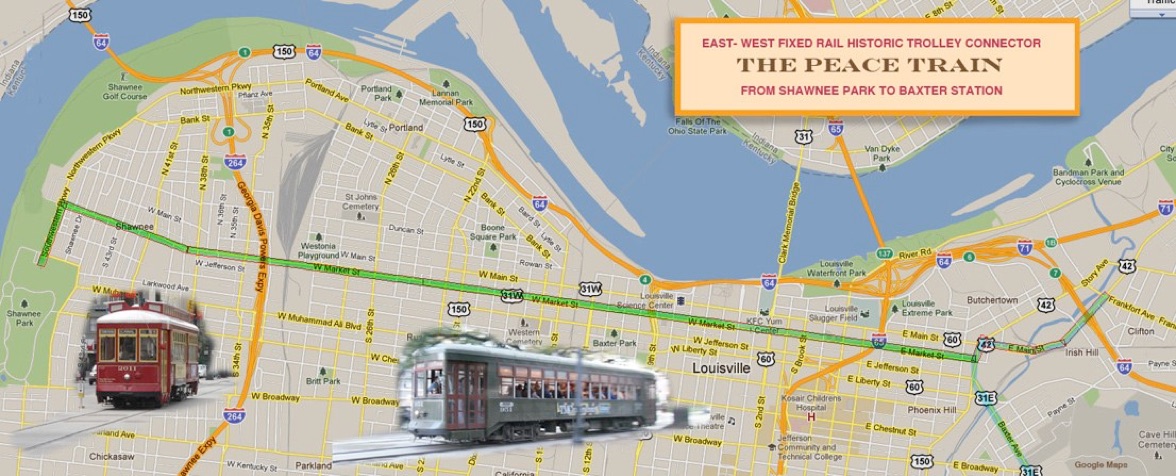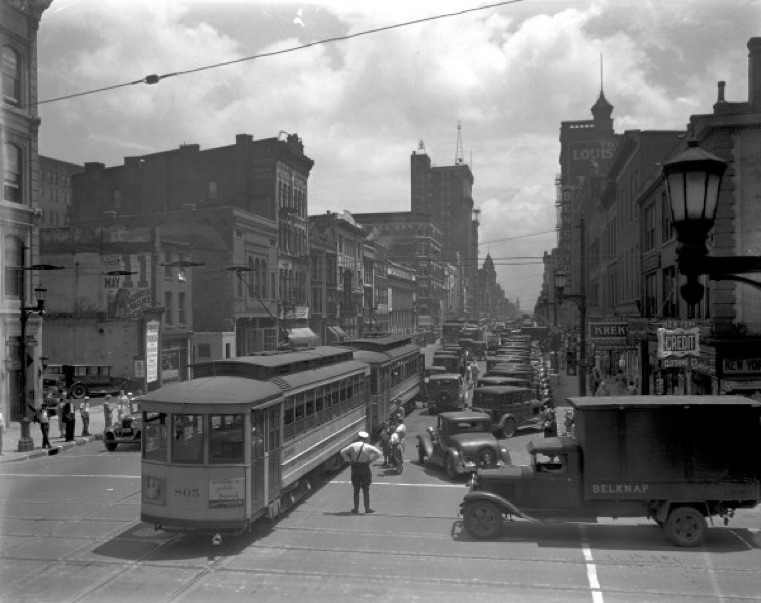
Original Proposal
-
1) Heritage Trolley Cars
Old style cars to compliment the Old Louisville Market Street
historic revival, Belle of Louisville, and museums. A tourist
attraction with functionality.
-
2) Local funding
Set up fabrication shops in the West End on brownfields and
train local workers including programs for criminal offenders.
Good paying blue collar jobs with health benefits to reduce 42%
unemployment in the west end, reduce crime rate and social
services costs.
-
3)Local corporate buy-in.
Site job training at the brownfields location to fabricate heritage
trolleys. Extend lines in the future and export finished trolley
cars as local industry.
-
4) Small business enhancement
Create Market Street trolley district to encourage business along
the fixed rail corridor. Build transit stations at each end and
middle with police station and/or government services.
See, Moving Louisville to a Sustainable Future HERE
-
•Shawnee Station
-
•Baxter Station
-
•22nd Street Station
-
5) Explore Zero carbon footprint
-
•photo-voltaic on top of cars
-
•ni-cad battery power
-
•possible cable car using Ohio River water wheel
-
6) Local workforce development to lay tracks
-
7) Explore continuation across bridge to New Albany along
existing tracks
-
8) Role of KIPDA and TARC ?
9) Role of GLI, Metro Council, Mayor?
send email: budhix@iglou.com to add your name to Peace Train
mail list
Benefits of Heritage Trolley Lines from <http://www.heritagetrolley.org/>
Denotes permanence
Investing in the fixed facilities needed for an electric, rail-based trolley system conveys to potential passengers, investors, and visitors that a permanent commitment has been made to provide transportation to the area. This can have important psychological benefits that tend to make positive contributions to urban development. The following is a statement prepared by a transit advocacy group relating to the potential return of light rail to the suspended Arborway streetcar line in Boston:
“The investment in construction of a permanent way, such as a street railway, conveys a long-term commitment to provide a high quality service now and into the future. Bus options, making no such commitment, are too easily rerouted or curtailed. The presence of such permanent facilities has demonstrated tangible, positive, private sector economic and social spin off effects. Real estate values in Brookline, Milton, and Newton (MA), would be just such an example, as well as the enduring popularity that light rail has in these localities. Often overlooked is the psychological factor where public facilities are concerned. Consider how many government and private institutions conduct their business in structures made of large stone blocks, or other durable materials. This serves to reassure the general public with an appearance of stability and endurance through the ages. No doubt it would have been more cost effective to place several trailers or tin sheds in an asphalt parking lot in lieu of the current Boston City Hall and plaza, but what does it say about our civilization? A street tramway conveys these same characteristics the public want so see preserved in our public facilities. Tramways can and do function in many places as a mobile traffic calming device, making the streetscape more pedestrian friendly.” – Fred R. Moore, Association for Public Transportation, Saugus, MA, June 2001
Inspires economic development
The permanent commitment demonstrated by the rails and overhead wire conveys to potential investors and residents that transportation will be available. Cities such as Portland, Memphis, and Tampa report strong developer interest along heritage lines, in some cases even before the line has opened. Both residential and commercial developments can benefit from the certainty that rail transit will be available. In Tampa, businesses have been so convinced of the benefits that heritage trolleys will provide that many have made financial contributions to the construction and/or operating costs of the line.
A Tampa report states: “Just the announcement that the [heritage trolley] project was going to be implemented has resulted in heightened development activity all along the corridor. An estimated $800 million in new development is either currently under way or will be under way before completion of construction of the line. This includes approximately 1,600 units of upscale high-density residential development never contemplated at the time that the project was in the development phase.” (See Tampa Project Description).
FROM 2008 TO 2010 METRO COUNCIL APPROVED MORE THAN $ 758 MILLION DOLLARS IN PUBLIC FUNDED
PROJECTS IN DOWNTOWN LOUISVILLE INCLUDING THE YUM ARENA--ALL THE PROJECTS WERE EAST OF 9TH STREET.
JEFFERSON COUNTY LEADERS ARE PURSUING THE $ 1.12 BILLION DOLLAR EAST END BRIDGE THAT
WILL EXPORT MILLIONS OF DOLLARS OF JOBS TO SOUTHERN INDIANA. LOCAL STUDIES SHOW
42% UNEMPLOYMENT IN WEST END COUNCIL DISTRICTS 1-6, AND 6000 FORECLOSURES IN THE AREA.
METRO COUNCIL HAS FUNDED FEW INFRASTRUCTURE IMPROVEMENT PROJECTS TO IMPROVE MOBILITY FOR
THE AFRICAN AMERICAN GHETTO CREATED BY NEGLECT IN THE WEST END. IT IS TIME FOR THE NEW
GENERATION TO CHOOSE THE FUTURE IN LOUISVILLE --WILL IT BE MORE SEGREGATION AND BEATING THE POOR
WITH A BIG ENFORCEMENT STICK - OR EQUITABLE INFRASTRUCTURE DEVELOPMENT?
Images of Louisville trolley service courtesy of the University of Louisville Photo Archives. The online web cite is above each photo description.
Click on the white to visit the photo archives page for full information.
http://digital.library.louisville.edu/cdm4/item_viewer.php?CISOROOT=/cs&CISOPTR=1043&CISOBOX=1&REC=4
1929
Men in suits stand outside the open doors of a trolley. The streetcar sign reads, "Broadway Express, Bardstown Road." Another trolley follows. The gentlemen wear suits, ties, hats, and shiny shoes. A young African American man in a buttoned up shirt and sweater stands in the road. He wears a cap and holds something in his left hand. Across the street is the Portland Building and Loan Association.
See also:
<http://www.flickr.com/photos/jaygalvin/4981209815/lightbox/#/photos/jaygalvin/4695395654/lightbox/>
1920
http://digital.library.louisville.edu/cdm4/item_viewer.php?CISOROOT=/cs&CISOPTR=827&CISOBOX=1&REC=5
A streetcar glides along its rails as it approaches the corner of Everett and Longest Avenues. On either side of the street, homes and sidewalks are visible.
1935
http://digital.library.louisville.edu/cdm4/item_viewer.php?CISOROOT=/cs&CISOPTR=688&CISOBOX=1&REC=9
A streetcar drives past buildings on Fourth Street at Liberty Street, Louisville, Kentucky. The streetcar bears the number 1083 and the designation "Park 3rd." The front of the bus has ads for Crab Orchard Kentucky Straight Bourbon "now 15 months old" and the Red Cross. A car is parked to the left behind a "Safety Zone" sign. On the far side of the street, part of Feltmen & Curme Shoe Stores can be seen.
1921
http://digital.library.louisville.edu/cdm4/item_viewer.php?CISOROOT=/cs&CISOPTR=880&CISOBOX=1&REC=11
A trolley runs down Market Street in front of the Louisville National Bank. Cars drive down Market or are parked diagonally along the street. Pedestrians walk along the sidewalks. Beyond the bank are Sullivan & Brach (a restaurant), Ed. H. Schoening (tailor), Clermont Cafeteria, a sign company, Wolf Blitz (glass and mirrors), Western Union, and another bank. On the other side of Market Street is Venhoff & Hillen (hats), Gordy (watches and diamonds), Raffo Furniture, Menter Co. (clothing), and Joe Eichele & Co. (hats and men's furnishings).
1933
Address: Market and Sixth Streets, Louisville, Kentucky. Streetcar 805 travels down Market Street and begins to cross Sixth Street. A truck from the Belknap Company waits while an officer oversees the intersection. A group of people is standing in the street, possibly waiting to board the trolley or to cross the street. Numerous cars are parked along the street and others attempt to maneuver around the trolley. Signs for businesses include the New York Clothing Co., Krekel Jeweler, and Ben Snyder. Written on the image is the date and time: May 27, 1933 / 11:15 A.M.
1928
A man with a suit and conductor's hat stands by the Broadway trolley while a bus is stopped next to it. Men stand by the front window of the trolley as the picture is taken. On front of the trolley are signs advertising, "[It]'s your Fair! [picture of horse and rider] We'll take you there!" and "First National, 5th & Court Place. Enjoy your own home. Kentucky Title Trust, Market West of 5th." Both the bus (#101) and the trolley (#1041) belong to the Louisville Railway Company.





